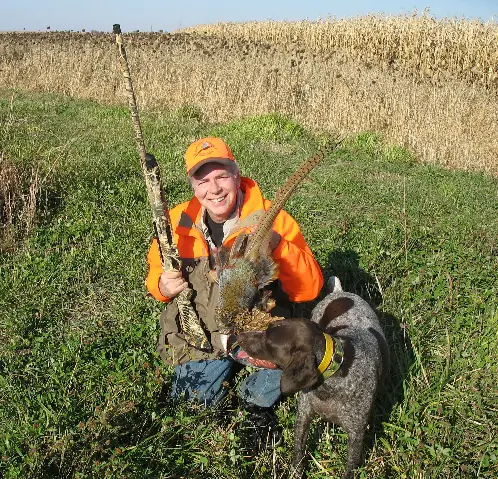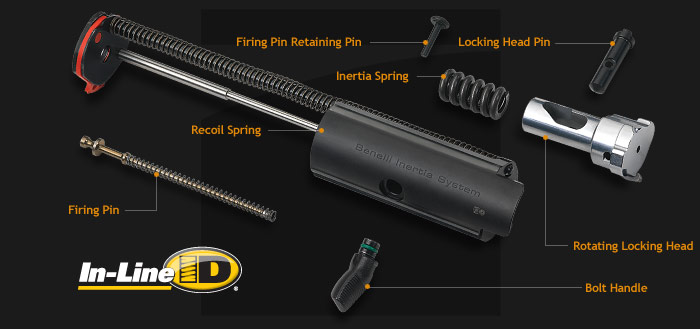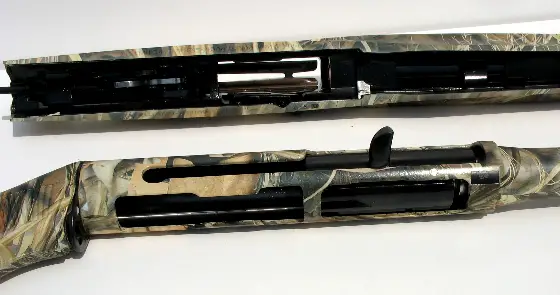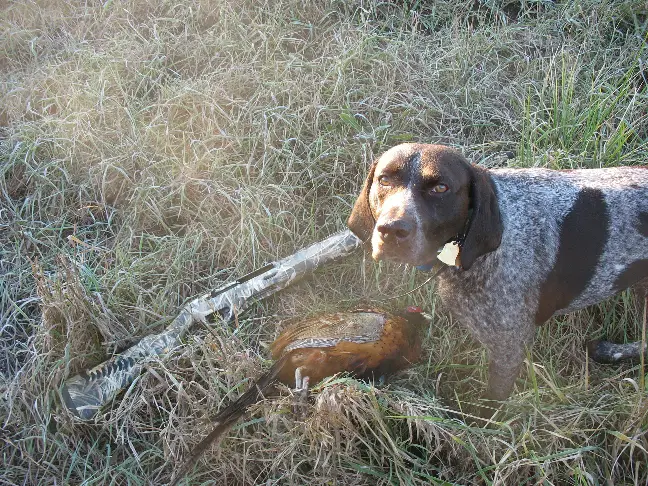


Hunting & Shooting with Benelli's Vinci 12 Gauge Autoloader

Buddy the Wonderdog seems far more intrigued with Benelli's Vinci than he is with his master's shooting ability.
The technical aspects of the Benelli Vinci were discussed at length in the Vinci: Indepth article. Beyond the initial testing evaluation of a firearm, particularly a dramatically new model of firearm, you tend to pick up a few things that were overlooked in the original testing phase. Things reveal themselves after you have lived with a gun for a while, both good and not so good.
Originally, both 26 inch and 28 inch models of the Vinci were tested. There have been assorted musings about what an ideal barrel length is or isn't in a wide variety of shotguns. I've often wondered what we would do if manufacturer's didn't state a barrel length? Then, we'd likely be a bit more inclined to choose what balances, shoulders, and handles the best for our field guns, rather than having a preconceived notion of what “better” might actually be for us. In any case, the 26 inch barreled model of the Vinci “did” it for me. For example, I've always liked the steel-receivered Browning B-80s, essentially the Beretta 303 action. Having more weight at center mass with the steel receiver smoothed out the gun considerably compared to its aluminum receivered counterparts. Though it remains one of my favorite all-time autoloaders along with the A-5, it seems to get heavier every year. The lightweight has its practical limits, the three quarters of a pound I leave behind with my B-80's compared to the Vinci every time I walk a lot won't ever be missed. The Vinci distributes its mass between the hands well with both models, but the 26 inch barreled version does it best.

Part of what makes the Vinci into a real "game-changer" is its inline action, all self-contained in the steel barrel itself. Without anything needing to protrude into the buttstock, hang off the barrel, or get stuffed inside the forearm-- the Vinci has between the hands balance you can't easily find otherwise. Along with its obvious simplicity, along with that comes almost complete lack of action stress and vibration to buttstock, forearm, or the front of the barrel.
One thing that can't be properly conveyed in a catalog (or an article) is how well a shotgun comes up. Yet, particularly for flushing game, how well a shotgun shoulders is just as important to me as anything else. I grimace a bit when I see supposed “field” guns with recoil pads closer to trap pads than anything else. You no doubt know the type, the genre of gun that snags on clothing, easily hanging up when you least want it. It may be preferable, perhaps ideal to have a gun that dictates to you exactly where your shoulder is going to be when shooting premounted clays games, but it is a clear hindrance in the field. That's one thing that the Vinci got right: the gun shoulders like lightning compared to several other shotguns. You really have to experience it first hand to appreciate the difference between a sea-slug slow shouldering scattergun and one that seems to automatically fly to your shoulder. The difference can be astonishing. The handling of the Vinci continues to impress. There is always a compromise when part of an autoloader's gas or recoil action resides inside the forearm, hangs off the barrel, or is pushed into the buttstock. As the Vinci eliminates the need for all three, the result is a quality of between-the hands balance just not possible with other designs, no matter how cleverly they might be executed.
It has been an unusual late summer / early fall in northern Illinois this year, to say the least. The end of August was punctuated with a cold snap that send doves southbound at just the wrong time and October has been cold and rainy in an unprecedented way. That's had the effect of leaving the field full of corn, with what little that has come out hitting 31% moisture content. On comes opening day of pheasant season, and instead of the usually clean fields we have tens of thousands of acres of standing corn, along with the 73 degree temperatures that we missed in October. They do call it hunting for a reason, though this year has been a bit of a nasty trick.
Buddy the wonderdog couldn't contain his enthusiasm, though, and we all gathered before light to get the show on the road. Walking all day to find roosters isn't unusual in January, but on the November 7, it sure is. I hadn't anticipated or hoped for the opportunity to carry the Vinci for nine hours on that Saturday, but that turned out to be the case. By the time a shot at a rooster presented itself, I was glad more than ever that the B-80s stayed home. The patterning work has long ago been completed, and it was a Trulock Precision Hunter Improved Modified extended choke tube coupled with Winchester Super Pheasant 1-3/8 oz. #5 shot loads that produced the patterns I was looking for. The Vinci shot to point of aim at 40 yards, noted here because so many shotguns do not.
The angry, cackling rooster got up at twenty yards or so, not at all a long shot. A windy day, he hit the sky and pumped his wings towards the standing corn alongside. What happened next I've never seen before; I wish I had a videotape of it. The Vinci came effortlessly to my shoulder and barked. There's never been a quicker kill made on a pheasant before. The rooster's head instantly left his body and tumbled forward in mid-air. The rest of the pheasant landed ten yards into the standing corn. If you refer to the picture above, you'll note the rooster has no head. The last thing that went through his mind is what just came out of a Trulock choke. It was a clean cut, with little damage-- as clean of a cut as you'd make with a hatchet. French physician Dr. Joseph-Ignace Guillotin would have been proud. I mentioned to my brother, who witnessed the shot, that “I'm told that strange things happen when you cryogenically treat a barrel.”
Back early on in the testing, I did have a couple of “Benelli clicks” without understanding why. As it turns out, it wasn't the Vinci at all-- the culprit was new factory shells with excessive rim thickness, measuring .074 in. to .075 in. far thicker than the common .064 – 065 inch area of most factory shells, and thicker than what my understanding is of the maximum allowable SAAMI dimension of about .072 inches. A bolt head only has room for so much headspace and when rim head thickness is out of whack, taking up more space than it it is supposed to, it is easy to see how a bolt cannot possibly rotate into battery smoothly. So, though it is odd, and Benelli has only heard of it a couple of times in the past, it is one more thing to check. I'll amend my original review of the Vinci right now to state there has been zero malfunctions with any shotshell of 1 oz. payload or better, as long as they were not defective, malformed shells. My apologies to Benelli for that one.
Crossing enough creeks, roads, and ditches during the day required a lot of clearing the chamber. The speed and ease of clearing and reloading the chamber is something anyone will appreciate of the course of a day like this. The Vinci is as close to a maintenance free autoloader as has ever been offered. Still, for best operation the breech assembly needs a small amount of lube. As Benelli likes to say, they will sure shoot dirty-- but they won't shoot dry. Benelli Customer Service speaks highly of Militec-1. I've used Breakfree CLP for years with good results. “Gun Oil” doesn't seem to have any precise meaning, but as of late I've been using “Montana X-treme Gun Oil.” It works supremely well in the Vinci, with no signs of gumming up or getting sluggish. You might want to give it a try. I don't think that there is any particular gimmick to Montana X-treme, it is just really good lubricant that is colorless, doesn't make sludge, and performs well.
From a practical perspective, it just makes sense that you become more proficient with a firearm that you practice with. I've enjoyed shooting skeet and sporting clays with A-5's, though an A-5 would not be considered the world's most popular clays gun. That's why guns that are uncomfortable to shoot or ponderous to swing hold such little appeal for me on both ends of the spectrum. You don't see too many 10 gauges breaking clays, so often the “specialty gun” aficionado ends up less than totally comfortable and confident with a limited-use type of shotgun. With the Vinci, breaking clays now and then presents no obstacle. It swings smoothly enough to be a fine skeet gun, even if hunting is where it shines most brightly.

Though the clean Vinci "upper and lower" satisfies from an engineering perspective, what makes it really shine is how well it actually all performs when used all day in the field.
The Vinci has been surprising in a lot of ways. From the original roll-out, some in the industry were surprised that the Vinci was a 3 inch chambered model, not a 3-1/2 inch version. I'm personally glad it wasn't. Placing the entire action of an autoloading shotgun solely inside the end of a steel barrel is a neat trick as it. The split bolt of the Vinci is longish as is, as are all Benelli's. More length is not at all desirable. Actually, I'm surprised that 3-1/2 inch “Super-Mags” still appear. Three inch 12 gauge loads already have the ability to throw far more payload than is needed, or wanted for most hunting applications. Kent Tungsten-Matrix loads are essentially the equal of lead, while Winchester HD tungsten bronze loads are superior to anything we've had before. Three inch Winchester HD 12 gauge loads can throw 1-5/8 ounces of shot and Kent TM three inch loads can toss 1-3/4 ounces. Both are heavier than 3-1/2 inch steel loads and far superior in downrange retained velocity and penetration. In the more is more department, three inch lead turkey loads still can throw a full 2 oz. of shot, enough to please most anyone that needs to feel their gun working. The omnipresent claim of frugality may drive those to the longer, yet far less effective steel loads. Yet, the truly thrifty hunters already know that if cost is really a factor, they can save about 25% by using 3 inch steel loads and lose nothing but the recoil if they are aware of and shoot within moderate ranges. As shotshell technology improves, 3-1/2 inch chambered guns are either less desirable or make less sense; take your pick.

This plump, early morning rooster made the mistake of hitting the air 45 yards in front of the Vinci. Buddy the Wonderdog might think this rooster fell dead from the sky solely from the incredible powder of his advanced canine mind-- but we think the Vinci just might have had a little bit to do with it as well.
The more time I spend with the Vinci, the more impressed and satisfied I've become. Often, with a new model, there is something that jumps out as a glaring oversight, or at least one component that is sorely in need of a revisit. I have yet to find that in the Vinci and its not for lack of trying. Lest the folks at Benelli find themselves in need of things to do, here's hoping there is a 20 gauge Vinci in the offing. The Vinci isn't great-grandpa's old gun, to be sure. It is likely the 12 gauge great-grandpa would be hunting with today, though, if he had his druthers.
Copyright 2009 by Randy Wakeman. All Rights Reserved.




